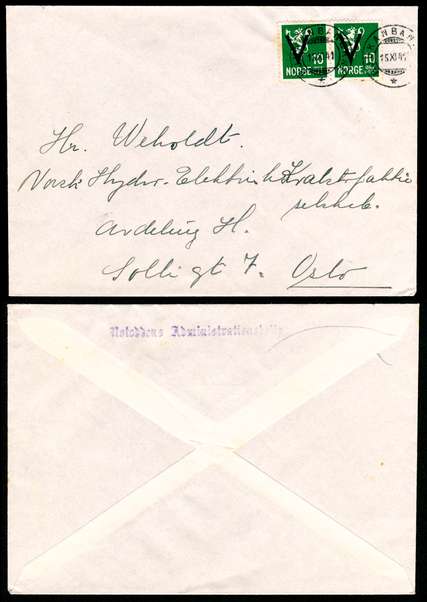| WWII Rjukan Norsk Hydro Heavy Water Plant |
| Item # |
|
US$ | ||
| 233071 |
10 øre V-Overprints pair (Scott #212 or #225; cannot be identified without removing from cover, which is too dangerous because of the other postal and WWII history of this cover) on a 15 November 1941cover with RJUKANBANEN railway postmark and sent to Oslo. This cover has an important story to tell, even though it looks "normal". It is, in fact, a normal domestic rate usage from a local provincial government office in the countryside to a large company in Oslo. But... the first important clue is the addressee: Norsk Hydro Electric. NHE owned the hugely important hydroelectric plant at Vemork, near the village of Rjukan, where heavy water was produced. The sender was a government office in the area of the hydro plant, thus the cover was probably not actually mailed on the train, but it was postmarked in the postal compartment of the train on the critically important 10-mile railway line, and sent to the main office of the company that owned and operated the hydro plant. This cover was in the "hands" of people intimately involved in a hugely important chapter of WWII and of nuclear history in general, from the Nazi guards on the train to the Oslo managers of the hydro plant. Just one year after this cover was mailed, a British Commando mission to the plant (Operation Freshman) failed when their plane crashed; the survivors were captured and executed by the Germans. ACTUAL item. |
500.00 Reference |
||
| 234356 |
150, 119 [1930 10 øre St. Olaf; 1927 20 øre Lion] (VF, F-VF) on 1930 cover from RJUKAN to the U.S. Missing back flap. While otherwise an ordinary use, it is the envelope which is part of an extremely important story. The sender privately used (and crossed out) an envelope pre-printed for the company "A/S RJUKANFOS / RJUKAN SALPETERFABRIKER" or The Rjukan Waterfall Company / Rjukan Saltpeter Factory. Saltpeter, a fertilizer, was a primary reason that the Vemork power plant was built at this waterfall. The electricity created there produced "artificial lightning" which fixed nitrogen from plain air, which was then used to produce nitric acid which was reacted with limestone to produce calcium nitrate or Norwegian Saltpeter. This product was critical to the agriculture of Norway and Europe and had a dramatic affect on the economy of Norway. The operating company was Norsk Hydro; A/S Rjukanfos was probably owned by or related to Norsk Hydro. Starting in the 1930s, the Vemork power plant started producing heavy water which is used in nuclear weapons production and research. This cover is a pre-cursor to the heavy water era and tells part of a story which has worldwide importance. Postal history related to this story is very scarce. ACTUAL item. |
45.00 Reference |